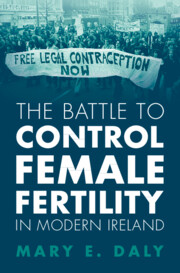132 results
10 - The Impact of the World Wars on Modern Sexuality
-
-
- Book:
- The Cambridge World History of Sexualities
- Published online:
- 26 April 2024
- Print publication:
- 16 May 2024, pp 204-226
-
- Chapter
- Export citation
12 - Sexuality in Post-war Liberal Democracies
-
-
- Book:
- The Cambridge World History of Sexualities
- Published online:
- 26 April 2024
- Print publication:
- 16 May 2024, pp 247-274
-
- Chapter
- Export citation
9 - Marriage and Families in the History of Sexuality
-
-
- Book:
- The Cambridge World History of Sexualities
- Published online:
- 26 April 2024
- Print publication:
- 16 May 2024, pp 183-205
-
- Chapter
- Export citation
22 - Sex in Sydney in the Twentieth Century
-
-
- Book:
- The Cambridge World History of Sexualities
- Published online:
- 26 April 2024
- Print publication:
- 16 May 2024, pp 465-486
-
- Chapter
- Export citation
9 - Birth Control and Reproductive Rights in the Modern World
-
-
- Book:
- The Cambridge World History of Sexualities
- Published online:
- 26 April 2024
- Print publication:
- 16 May 2024, pp 183-203
-
- Chapter
- Export citation
13 - Sexuality in Christian Traditions
-
-
- Book:
- The Cambridge World History of Sexualities
- Published online:
- 26 April 2024
- Print publication:
- 16 May 2024, pp 271-292
-
- Chapter
- Export citation
Sexually transmitted infections, sexual life and risk behaviours of people living with schizophrenia: systematic review and meta-analysis
-
- Journal:
- BJPsych Open / Volume 10 / Issue 3 / May 2024
- Published online by Cambridge University Press:
- 10 May 2024, e110
-
- Article
-
- You have access
- Open access
- HTML
- Export citation
11 - Adolescent Decision-Making and Healthcare
-
- Book:
- Fortin's Children's Rights and the Developing Law
- Published online:
- 08 February 2024
- Print publication:
- 29 February 2024, pp 409-444
-
- Chapter
- Export citation
Chapter 7 - W. B. Yeats, the Irish Free State, and the Rhetoric of Race Suicide
-
-
- Book:
- Race in Irish Literature and Culture
- Published online:
- 04 January 2024
- Print publication:
- 18 January 2024, pp 143-171
-
- Chapter
- Export citation
11 - Conservation Breeding, Reproduction and Genetics
-
- Book:
- Zoo Studies
- Published online:
- 12 May 2023
- Print publication:
- 01 June 2023, pp 262-293
-
- Chapter
- Export citation
Introduction
-
- Book:
- The Battle to Control Female Fertility in Modern Ireland
- Published online:
- 11 May 2023
- Print publication:
- 25 May 2023, pp 1-8
-
- Chapter
- Export citation

The Battle to Control Female Fertility in Modern Ireland
-
- Published online:
- 11 May 2023
- Print publication:
- 25 May 2023
4 - ‘An Ascetic Epicureanism’
-
- Book:
- Sexual Restraint and Aesthetic Experience in Victorian Literary Decadence
- Published online:
- 02 March 2023
- Print publication:
- 09 March 2023, pp 145-174
-
- Chapter
- Export citation
9 - Family Planning after the Family Planning Act
-
- Book:
- Contraception and Modern Ireland
- Published online:
- 16 February 2023
- Print publication:
- 23 February 2023, pp 293-321
-
- Chapter
-
- You have access
- Open access
- HTML
- Export citation
6 - Family Planning Clinics and Activism in the 1970s
-
- Book:
- Contraception and Modern Ireland
- Published online:
- 16 February 2023
- Print publication:
- 23 February 2023, pp 184-221
-
- Chapter
-
- You have access
- Open access
- HTML
- Export citation
Conclusion
-
- Book:
- Contraception and Modern Ireland
- Published online:
- 16 February 2023
- Print publication:
- 23 February 2023, pp 322-324
-
- Chapter
-
- You have access
- Open access
- HTML
- Export citation
1 - Access to Contraception and Family Planning Information in Ireland from the 1920s to the 1950s
-
- Book:
- Contraception and Modern Ireland
- Published online:
- 16 February 2023
- Print publication:
- 23 February 2023, pp 21-50
-
- Chapter
-
- You have access
- Open access
- HTML
- Export citation
4 - The Pill, Women’s Agency and Doctor–Patient Relationships in the 1960s and 1970s
-
- Book:
- Contraception and Modern Ireland
- Published online:
- 16 February 2023
- Print publication:
- 23 February 2023, pp 129-150
-
- Chapter
-
- You have access
- Open access
- HTML
- Export citation
Introduction
-
- Book:
- Contraception and Modern Ireland
- Published online:
- 16 February 2023
- Print publication:
- 23 February 2023, pp 1-20
-
- Chapter
-
- You have access
- Open access
- HTML
- Export citation
5 - The Catholic Church, ‘Sympathetic’ Priests and Religious Influences on Family Planning Practices after Humanae Vitae
-
- Book:
- Contraception and Modern Ireland
- Published online:
- 16 February 2023
- Print publication:
- 23 February 2023, pp 151-183
-
- Chapter
-
- You have access
- Open access
- HTML
- Export citation



